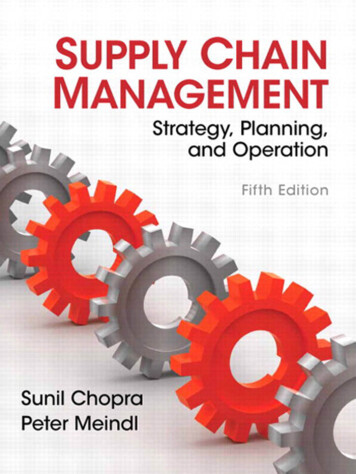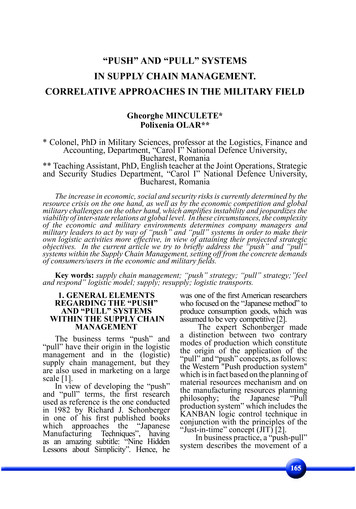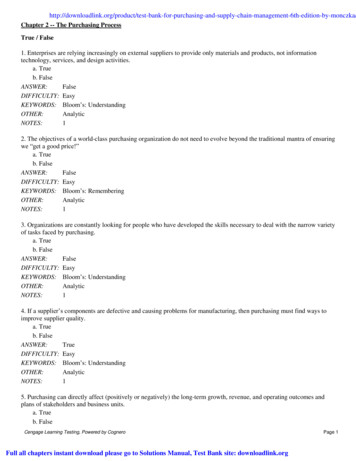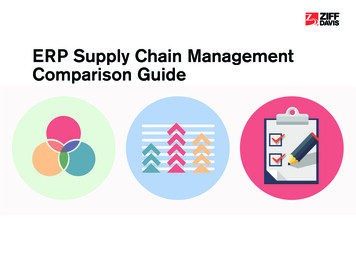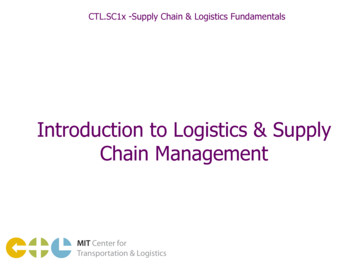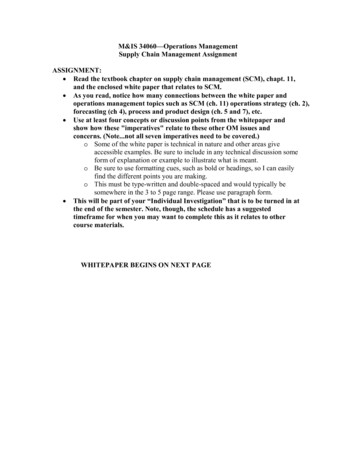
Transcription
M&IS 34060—Operations ManagementSupply Chain Management AssignmentASSIGNMENT: Read the textbook chapter on supply chain management (SCM), chapt. 11,and the enclosed white paper that relates to SCM. As you read, notice how many connections between the white paper andoperations management topics such as SCM (ch. 11) operations strategy (ch. 2),forecasting (ch 4), process and product design (ch. 5 and 7), etc. Use at least four concepts or discussion points from the whitepaper andshow how these "imperatives" relate to these other OM issues andconcerns. (Note.not all seven imperatives need to be covered.)o Some of the white paper is technical in nature and other areas giveaccessible examples. Be sure to include in any technical discussion someform of explanation or example to illustrate what is meant.o Be sure to use formatting cues, such as bold or headings, so I can easilyfind the different points you are making.o This must be type-written and double-spaced and would typically besomewhere in the 3 to 5 page range. Please use paragraph form. This will be part of your “Individual Investigation” that is to be turned in atthe end of the semester. Note, though, the schedule has a suggestedtimeframe for when you may want to complete this as it relates to othercourse materials.WHITEPAPER BEGINS ON NEXT PAGE
High Performance in a Volatile WorldSeven Imperatives for AchievingDynamic Supply Chains
2
IntroductionIncreasing economic volatility hasseverely disrupted the supply chainsof companies across industries.Rapid swings in the availability andprice of key commodities, majorcurrency fluctuations, upheavalin financial markets, disruptivegeopolitical events and continueddevelopment of customer channelson a global basis have conspired toplace unprecedented pressure onthe way these companies source,manufacture and distribute products.Accenture research has found thatthose with very dynamic and wellsynchronized supply chains can usesuch volatility to their advantage.Companies that want to do so faceseven imperatives, which we describeand illustrate in this paper.Large, global companies facenumerous challenges in today’stumultuous economic climate.One of the biggest is creatingdynamic supply chains that helpa company achieve and maintainhigh performance—despite majorfluctuations in demand and supply,significant changes in commodityavailability and prices, big swings incurrencies, unforeseen geopoliticalevents and the need to align to bothmature and emerging high growthmarkets. Customer expectationsare high and rising, and globalcompetition has dramaticallyshortened the lives of products fromcellular phones to automobiles.Innovations are commoditizedin weeks or months rather thanyears. Unpredictable commodityand transport costs can render“low-cost” offshoring a high-costalternative, continuously forcingcompanies to reevaluate how andwhere they source, manufacture anddistribute products.Research that Accenture hasconducted going back to 2003 hasfound that supply chains have adisproportionate impact on corporateperformance relative to the attentiongenerally paid the function inmost companies1. According tothis research, a supply chain canaccount for between 50 percentand 70 percent of a manufacturer’stotal costs of doing businessand more than 50 percent of itsassets. It can also have significantimpact on customer service andsales. Reflecting this prominence,a clear majority of executives (89percent) say supply chains are coreto business success and that theirimportance is growing. To put itbluntly, not only do more dynamicsupply chains result in superiorcorporate performance, but it isalmost impossible to overcome thenegative bottom-line impact of moretraditional supply chainmodels in today’s permanentlyvolatile environment.3
4
Figure 1. The seven supply chain imperatives combine todrive high performance.Accenture further has found in ourclient experience that the mostsuccessful companies clearly aligntheir supply chain operations with thevalue proposition of the business andinvest in those operational areas thatlead to highest shareholder return. Infact, we have found business practicesand capabilities that are a greatstrategic fit with the overall focus ofthe business—and can execute reliablyand flexibly—can play a major rolein helping companies generate cash,reduce operational costs, improveasset productivity, optimize their taxliabilities, drive revenue growth andmarket differentiation and fostergreater environmental sustainability.In more recent research, completedat the end of 2008, Accentureinterviewed 1,500 executives in NorthAmerica, Europe and Asia from morethan 600 companies in 10 industries.(Nearly half—48 percent—were incompanies with at least 1 billionin annual revenue.) As we studiedhow these organizations designand manage their supply chains forsuperior performance, it becamerapidly apparent that no one silverbullet could explain success. We did,however, identify seven fundamentalguiding principles that effectively serveas a line of demarcation between awould-be and a true high-performancebusiness (see Figure 1).Four of the imperatives focus onstrategic fit the linkage between thecorporate vision and strategy with thesupply chain vision and strategy. Theseimperatives are to:1. Articulate a clear value creationalgorithm.2. Approach the supply chain as avalue delivery system.3. Segment the supply chainand consistently adapt it to thecharacteristics of each segment.4. Optimize the global operationarchitecture for scale, access, flexibilityand risk mitigation.The remaining three imperatives focuson execution–the ability to turn thestrategy into business practices thatare performed flawlessly on a dailybasis. These imperatives are to:5. Selectively invest for mastery indifferentiating capability areas.6. Deploy information systems thatdeliver insightful analytics, alignmentand responsiveness.7. Drive process execution disciplinewith the right talent powered by aculture that enables high performance.Companies that excel in these sevenareas will be better positioned todevelop, source, manufacture anddistribute superior products at lowerrelative costs; increase revenue, profitand shareholder value faster thancompetitors; and more effectivelyanticipate customer needs and meetthem profitably.In the remainder of this document,we explore these imperatives andprovide examples of how leadingcompanies have addressed them tobuild supply chains that help drivehigh performance and competitiveadvantage in an era of unprecedentedvolatility and uncertainty.5
Imperative No. 1: Articulate a clear value creation algorithmFigure 2. The two elements of a value creation algorithm.Our research and client work haverevealed that companies with superiorsupply chain performance have a clearunderstanding of how they createvalue for customers. In addition, thesecompanies know what they need to doin the future to provide even greatercustomer value and thus fuel their owngrowth. We refer to this as having a“value creation algorithm,” and it hastwo core elements (see Figure 2): Value proposition orientation—Whata company (or business unit) is knownfor, its market differentiation and whatthat differentiation requires of itssupply chain. Growth orientation—What thebusiness must focus on (in terms of itscustomer segments, product/serviceoffering, channels to market andgeographies) to generate current andfuture growth.While it may appear simple, clearlyarticulating a company’s position onthose two dimensions is not easy.Yet doing so is crucial to creating a6supply chain that contributes to highperformance, and the best companiesin our survey had clearly definedthemselves in the two areas.The Value PropositionOrientationEvery organization has fivefundamental ways in which it cangenerate customer value: Product leadership—unique productand service features (for example,the sound quality of Bose audiospeakers, the user interfaces ofApple computers, cell phones andmusic players, and the attractivenessof LVMH Group’s luxury apparel,perfumes, watches and otherconsumer products) Speed to market—a rapid productlifecycle turnaround (such as thatexhibited by apparel maker andretailer Zara) Customer experience—thequality and personalization of eachinteraction (as demonstrated by suchcompanies as online shoe retailerZappos and the personal experienceof the local Starbucks shop) Price competitiveness—a lowerrelative price point for given productfeature (Wal-Mart is the undisputedleader in this area) Choice extensiveness—the breadth ofthe product catalog and configurabilityof solutions (Amazon.com has builtthe world’s leading online business bypursuing this avenue to value whereasWW Grainger is well known in theindustrial distribution world for itsbroad product line)Many executives say their companypursues all five value propositions.However, as a company approachesworld-class operations in any oneof the five it becomes increasinglydifficult to fulfill the other competingpropositions. In fact, in somesituations, the operations requiredto fulfill the five objectives can bemutually exclusive, thus making itimpossible to be world-class in all fivewith a single operating model. With
a clearly chosen and articulated valueproposition orientation, companiescan make effective operationaltrade-offs and build the appropriateoperating models to fulfill demandfor different customer segments anddifferent value propositions.High-performance businesses domake such choices and do so moreexplicitly than not. Take Apple Inc.The company’s value proposition isclear: product leadership. In turn,Apple has created a supply chainthat is highly tuned to deliver thisvalue proposition. Consumer audioproduct manufacturer Bose isanother good example. Bose looksfor technical ideas that no one elsehas commercialized. It then makesits product look very different so thatconsumers will take interest longenough to understand the technicalproduct differentiation. Forty yearsafter its founding, Bose remains trueto the principle of product leadershipand drives all aspects of the businessfrom this vision.2The Growth OrientationIn addition to clearly understandingwhat customer value they should focuson, leading manufacturers are better atdetermining where, how and to whomto provide that value. Masters have amuch better sense of which customersto target, how to reach them (marketingmessages and distribution channels)and in what regions of the world.Clearly defining the company’svalue creation algorithm is a criticalstep in designing and operating asuperior supply chain that driveshigh performance. High-performancebusinesses have a sharp understandingof how they create value forcustomers, where they are and the bestways to reach those customers.7
Imperative No. 2: Approach the supply chain as a valuedelivery systemFigure 3. Redefining the supply chain as a value delivery system.Conceiving of a supply chain as havingfour core elements—“plan,” “buy,”“make” and “move”—today is far toolimiting. Designing and managingsupply chains for high performancerequires a far more comprehensiveview of the supply chain (see Figure 3),one with three broad components: An ecosystem of partners—suppliers, suppliers’ suppliers,customers, customers’ customers,internal stakeholders, third-partyservice providers Three mega-processes—productdevelopment chain, order-to-deliverychain, and service and returns chain Six flow types—physical, services,information, financial, legal and digitalWith this broader perspective,companies can identify a greaternumber of opportunities to innovateand improve performance. In addition,by seeing the interconnections amongthese elements, they are less likely tosuboptimize the whole by optimizingone of the parts.8Nokia shows the benefits that canresult when a supply chain is anintegral part of a broader valuedelivery system. With approximately112,000 employees worldwide, Nokiais the largest mobile phone maker inthe world and consistently delivershigher profitability than peers. Nokiais able to sustain a highly efficientsupply chain while quickly adaptingto fast-changing consumer cell phonepreferences by using innovative andinterlinked design, supply, productionand logistics strategies. For example,Nokia designs handsets to not onlyshare parts but also to have fewer partsthan competing models. This enablesthe company to help reduce designand production complexity, as wellas reduce procurement costs due tovolume discounts on parts and the needto stock fewer types of components.Nokia’s value delivery system is alsoable to react quickly to overcomeobstacles, adjust to changing marketconditions and capitalize on emerginggrowth opportunities. The companymade a focused push into emergingmarkets in 2003 and is now No. 1 inthe world’s fastest-growing markets.Nokia teams live in emerging marketsto know the customers and howthey are different from customers inestablished markets. Such knowledgeenables Nokia to make adjustmentsin products, pricing and distributionchannels that are closely tuned to thelocal markets’ needs. For instance,Nokia grew its handset market sharein India to 55 percent in part becauseit discovered that in that country aflashlight on the handset was a desiredfeature among consumers and quicklyincorporated one in the handset’sdesign. Nokia also demonstrated itsecosystem adaptability after a factoryfire at one of its component suppliers.The company made changes to achip design, launched a productionboosting project and workedintensively with supplier networks tohelp reduce disturbances in sales.
Imperative No. 3: Segment the supply chain and consistently adaptit to the characteristics of each segmentFigure 4. Designing the supply chain from the outside in.To be sure, not all customers arecreated equal. In most companies, theminority of customers are the sourceof the majority of the profits. Yetmost companies’ supply chains tendto treat all customers the same. Sucha one-size-fits-all approach preventsa company from differentiating itself,and it leads to over-investing in areaswith little added value.High-performance businesses, however,do not treat all customers and productsthe same, and their supply chainsreflect that reality. They segment theircustomer base and products withinmarkets and channels. And they usesuch segmentation to configure theirsupply chain responses and operations.Their supply chain design starts fromthe outside in (see Figure 4):1. Segmenting the customer base.Having determined in which marketsthey want to win, high-performancebusinesses focus on the customerand customer’s customers withinthat market and channel. Theyconduct research to determinetheir relative importance/value,what they really value (known andunknown) and the supply chainimplications of the company’s valueproposition orientation. And, theyhave implemented ongoing demandsensing capabilities that allow themto modify their approaches as demandcharacteristics change.2. Profiling demand. High-performancebusinesses profile the demand oftheir customer segments, usingsuch variables as volume, degree ofpredictability and relative lead time.They then use detailed analyticsto segment demand signals at anindividual SKU level. For example,one-off promotions with a specificretailer may have a different demandprofile than promotions across multipleretailers with different SKU or producttypes (see Figure 5).Cisco is one company that excelsin profiling demand. The companysells to large and medium-sizedtelecommunications and cablecompanies globally. Its products arehighly specialized, often customconfigured, highly complex and veryexpensive. But Cisco also sells productsto consumers such as Internet routersthrough retailers. In addition, thecompany sells to many value-addedresellers and distributors. To add tothe complexity, Cisco outsources 90percent of production. Because of thismassive diversity in products, channelsand customers, Cisco historically hasfound demand planning to be extremelydifficult, especially with Internet serviceproviders such as telcos and cable TVcompanies. To better assess demand,the company has extensively usedcollaboration and Web 2.0 technologies.The result: a dramatic improvement inon-time delivery performance, from 65percent to the high 90th percentile.33. Aligning the supply chain withdemand profiles. Many companies stopafter profiling customer demand fortheir products. But high-performancebusinesses take one more step: usingdemand profiles to segment theirsupply chains. As they extend theiroperational footprint around theworld, manufacturers must intimatelyunderstand their supply chainenvironment and maturityacross geographies.9
Figure 5. Demand profiles can vary substantially across customer segments.High-performance businesses identifya number of supply chain designsto deliver their value propositionacross the range of targeted andprioritized demand/supply segments.The case of Procter & Gamble’s (P&G)consumer-driven supply network(CDSN) is illustrative. P&G’s supplychain design starts at the store shelfand works its way back throughthe supply network. For some largeretailers, P&G manufactures andreplenishes based on real demand(scanned at the store check out).Some manufacturing plants run on asix- to eight-hour response time basedon aggregated sales data. The CDSNbecomes especially critical when P&Glaunches new products, as it helps P&Gto correct course quickly when realdemand varies from forecast.P&G’s dynamic supply network alsoenables it to customize product forspecific customers or promotions.10And, on a more basic level, P&G iscustomizing pallet assortments ofdifferent SKUs for customers. It isdesigning smaller and larger packagesizes for specific customers, as wellas special packaging and productpresentations. To provide such productcustomization, P&G is reconfiguringmanufacturing, including adding moreslow lines in certain plants to creategreater flexibility.4
Imperative No. 4: Optimize the global operation architecture forscale, access, flexibility, and risk mitigationCoreContributes tocompetitiveadvantage tothe companyContextualDoes not contribute tocompetitive advantageto the comapnyMission criticalIf performed poorlywould pose animmediate threat tothe companyIn-houseOut-task and controlNon-mission criticalIf performed poorlywould not pose animmediate threat tothe companyOut-task andmaintain somecontrolOutsource and giveup controlFigure 6: Understanding the differences between resources and capabilitiesmakes for better sourcing decisions.By segmenting its supply chain, amanufacturer determines what eachcustomer segment needs to maximizerevenue. However, that manufacturerthen must create the resources5and capabilities6 necessary todeliver customized products andtailored distribution. We refer tothe design of those supply chainresources and capabilities as itsoperations architecture.Designing the operations architectureis neither straightforward nor simple.In exploring a number of supplychain configurations, managers mustbalance cost, service, risk, flexibilityand increasingly other outcomes(such as their supply chain’s carbonfootprint). High-performancebusinesses develop their resourcesand capabilities in four ways:They design an operatingmodel that is simple on theinside and differentiated onthe outside.Providing tailored products, packaging,distribution and other services tocustomers gives manufacturersan edge. However, unless suchcomplexities are managed, they alsocan give a manufacturer an unwieldycost structure. The best supply chainsgive a manufacturer the differentiationit needs but ensures that its operationsarchitecture is simple and costeffective. Most companies optimizesupply chains at the tactical level,using Lean Six Sigma and otheroperational improvement techniquesto improve assets such as factories,warehouses or transportation routes.High-performance businesses go onestep further. They take a holistic viewof their operations architecture andrigorously determine where they canshare capabilities or resources acrosssupply chains or business units.They focus on value, notassets.In optimizing their operationsarchitecture, high-performancebusinesses shift away from managingassets to controlling the processesthat ensure quality, service, marketaccess and cost efficiency. Coca-ColaCompany is a great example. In 2006,after working on a series of smallprojects to improve the company’s andits independent bottlers’ operations,Coke and a team of bottlers launcheda major initiative to move to commonprocesses and data standards. Theteam discovered that 90 percent ofmore than 400 business processesbottlers used were common to themall. It also learned that many bottlerswere planning software upgradesin the near future. Coke and thebottlers detailed more than 650business processes, from procuringraw materials to selecting and pricingproducts, managing retail relationships,paying suppliers and invoicingcustomers. Through this collaborativeand common platform, Coke hopes thatby sharing its technology expertise, itcan drive greater sales for both itselfand its bottlers.7Implementing such a “value, notassets” approach requires companiesto understand which core resourcesor capabilities create its competitiveadvantage and which do not (in other11
LeversExampleIllustrative OutcomesAdapt to localspecificities Local distributionalliance group to tailordistribution strategy tospecific market context Improve reach and customerrelevance in local markets Neutralize local competitorsBuild globaleconomies of scale Centralizedmanufacturing of aspecifc line of product Spread fixed costs overlarger volumes Reduce capital/operatingcosts per unit Consolidate purchasingpower Better serve globalcustomers Build critical mass in selectactivities Leverage broader knowledgebase Reduce costs Improve performance Mitigate risks Supply chain analyticsBuild globaleconomies of scope global Center ofExcellenceOptimize theconfiguration ofthe value chain Optimally spreadmanufacturingcapabilities globallyFigure 7: Striking the right balance among key levers.words, which are “core” or “context”).It also requires determining whatresources would pose an immediatethreat to the company if they wereperformed poorly.Armed with such a framework,high-performance businessesgain a structured perspective oftheir operations architecture andeffectively push the traditionalboundaries of insourcing andoutsourcing (see Figure 6).They convert their globalfootprint to a competitiveadvantage.Supply chains that drive highperformance are increasingly globalin nature. They force a multinationalcorporation to shift from focusingon what to buy and sell in differentcountries (the transaction-orientedworld of imports and exports) todetermining where to locate businessfunctions such as design, sourcing,manufacturing, distributing, selling,marketing and product supportglobally. In the past, such companies12managed their operations locally,with cross-country coordinationoccurring largely in consolidatingfinances. As their geographicallydispersed operations become moreinterdependent, companies need tofind the right balance in market access(or local adaptation), economiesof scale, economies of scope andoptimized global value chainconfiguration (see Figure 7).To be sure, there is no silver bulletfor reaching the right balance (andtension) among local, regional andglobal priorities and decision-makingauthorities. However, recent Accentureresearch found the most successfulcompanies globalize the value chainof a product or product line ratherthan a specific function. They alsotend to choose those products orproduct lines that are most amenableto globalization and are more likely todevelop hemispheric rather than globalsupply chains to mitigate cost andservice issues. Finally, global leaderstypically defined the strategy from thetop down to paint the “big picture” butimplemented it from the bottom up insmall, manageable pieces.
Capacity is vital because it can beflexed to respond. and allows a supply chain tomanage the unexpectedTypes of supply chains Where demand cannot be reliablyforecasted, capacity allocations andoperational decisions must be prioritizeddynamically as demands change Advanced capabilities are needed toexecute - smart, skilled people, flexibleorganization, fast information flows,adaptive technologies and well definedbusiness decision frameworks. Where demand can be forecasted,planning is feasible and basic decisionmaking can be automated Standard IT system can support mostprocesses, freeing up people Future technologies will do even betterFigure 8. Flexibility enables a company to respond more quickly and cost effectively.They build in flexibility toextract risk.As supply chains globalize, theyface many more potential sourcesof disruption and, therefore, risks.Building in operational flexibility towithstand such disruptions is crucial.Consider Dow Chemical. It recentlywas confronted with an energy crisis inArgentina. During one of the country’scoldest winters on record, consumerdemand skyrocketed for natural gasto heat homes. The government cutbusiness consumption of gas andredirected it to consumers. Dowwas forced to reduce capacity at itsArgentina plants to 25 percent ofplanned output. However, the companywas able to quickly shift production toplants on the Gulf Coast of the UnitedStates. It moved all production andshipping in 30 to 45 days. Its productiononly fell 3 percent for the region servedby its Argentina operations.9from creating a global supply chainthat mutes the uncertainty ofinternational markets, producinga number of products at the sameplants, building capacity redundancy,designing products on modular productarchitectures and delaying decisionsabout which products to make till thelast possible moment, and strikingflexible contracts and dual-sourcingstrategies with vendors.How does one build such flexibilityinto the supply chain? Highperformance businesses draw ona portfolio of measures, ranging13
Imperative No. 5: Selectively invest for mastery in differentiatingcapability areasFigure 9. Supply chain domains in which mastery is correlated with highperformance.Accenture's research on the supplychains of more than 600 companies in10 industries around the world showsthat domain mastery can generatesubstantial business value. We foundmasters’ median performance on all 68measured metrics is about 17 percenthigher than that of non-masters. Infact, the masters’ median performancewas 50 percent higher on 22 metrics.Do companies need to master allsupply chain dimensions? The answeris no. Our initial waves of researchon high performance clearly showedthat high-performance businessesoutperform peers on a limited numberof, but highly critical, aspects oftheir operations. From a supply chainperspective, this means excelling inone or two key domains—fulfillmentand planning, for instance—whileperforming at or near industry averagesin the rest. In doing so, they avoidinvesting more money than necessary inlow-return, low-impact areas.14As noted in Figure 9, a company’svalue proposition orientationlargely determines the domainsin which the enterprise must exceland those in which it must maintainaverage performance.
Imperative No. 6: Deploy information systems that deliver insightful analytics, alignment and responsivenessFigure 10. Using metrics to answer key questions about the business.The supply chains of high-performancebusinesses require unprecedentedlevels of coordination and alignment.They must push down decisionmaking throughout the network butmake sure those decisions are not inconflict. Performance expectationsmust be in sync, and manufacturing,sourcing, warehousing and distributionmanagers must share accountabilityto meet those goals. This is a criticalsuccess factor, indeed, but one that isdifficult to achieve.A powerful supply chain analyticscapability makes addressing thischallenge possible. To begin, highperformance businesses establishkey metrics and performance levels.Understanding which metrics aremost important and actionableby role clarifies how people canmore logically participate. It makestradeoffs more visible.Dow Chemical, for instance, hascreated a key metric and methodologyfor assigning risk to each of its rawmaterials. The metric—Purchasing Riskand Mitigation (PRAM)—is based on thebelief that supplier problems account forthe large majority of plant shutdowns.Dow supply chain managers assign aninitial and a final score to each rawmaterial. The initial score is based on thedrivers of supply of that good, namelythe number of suppliers and plantsthat make the material. The managersthen determine how to reduce the riskand the cost of doing so to arrive at apotential final score. Since launchingthe PRAM program, half of Dow’sPRAM assessments have resulted in riskmitigation actions.10Having a single source of facts enablesmanagers to stop arguing aboutperformance deficiencies and insteadconcentrate on how to fix them (seeFigure 10). It helps them tap thecreativity and competitive spirit of theirpeople to improve those outcomes.All this requires access to informationand technology to process thatinformation. The following are someof the foundational IT capabilities andmaster data structures our research andclient work have found to be most vital: More integrated enterprise systems —Integrated operating models require newlevels of integration in enterprise andsupply chain systems. Global visibility and execution—Global operations necessitate global,Web-enabled visibility (to demand,sourcing and spending, workingcapital and asset management and/or operations) and global enterpriseplanning/execution capabilities. Dynamic response—Rapid changesin market conditions require adaptivesystems for product innovation,pricing, costing, scale efficiencies, andoperational resilience. New organiza
Supply Chain Management Assignment ASSIGNMENT: Read the textbook chapter on supply chain management (SCM), chapt. 11, and the enclosed white paper that relates to SCM. As you read, notice how many connections between the white paper and operations management


